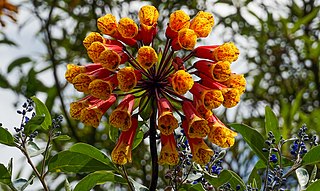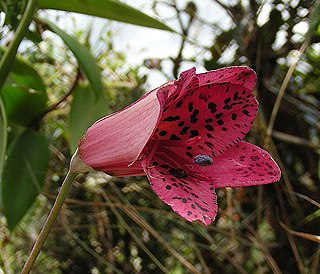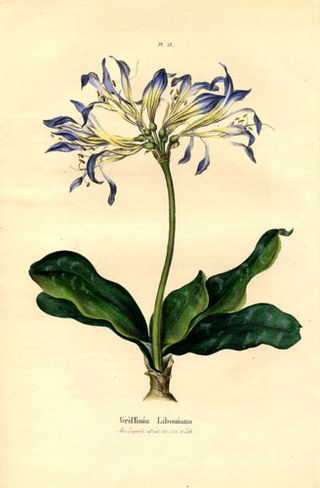Alternanthera areschougii is a species of plant in the family Amaranthaceae. It is endemic to Ecuador. Its natural habitats are subtropical or tropical dry forests and subtropical or tropical dry shrubland. It is threatened by habitat loss.
Anthurium gualeanum is a species of plant in the family Araceae. It is endemic to Ecuador. Its natural habitats are subtropical or tropical moist lowland forests and subtropical or tropical moist montane forests. It is threatened by habitat loss.
Anthurium pallatangense is a species of plant in the family Araceae. It is endemic to Ecuador. Its natural habitat is subtropical or tropical moist montane forests. It is threatened by habitat loss.
Anthurium pallidiflorum is a species of plant in the family Araceae. It is endemic to Ecuador. Its natural habitat is subtropical or tropical moist lowland forests. It is threatened by habitat loss.
Anthurium rigidifolium is a species of plant in the family Araceae. It is endemic to Ecuador. Its natural habitat is subtropical or tropical moist montane forests. It is threatened by habitat loss.
Bomarea angustifolia is a species of flowering plant in the family Alstroemeriaceae. It is endemic to Ecuador, where it is known from a single collection made during the first half of the 19th century. It is not clear exactly where the specimen was collected, but it may have been near Loja.
Bomarea borjae is a species of flowering plant in the family Alstroemeriaceae. It is endemic to Ecuador. It is known only from two collections made in the caldera of the dormant volcano Pululagua over 100 years ago. It is not a well-known species and is threatened by habitat loss.
Bomarea brachysepala is a species of flowering plant in the family Alstroemeriaceae. It is native to Peru and Ecuador. It grows in mountain forest habitat in the Andes. It is threatened by destruction of habitat caused by deforestation and mining.
Bomarea ceratophora is a species of flowering plant in the family Alstroemeriaceae. It is endemic to Ecuador, where it is known from only two collections.
Bomarea chimborazensis is a species of flowering plant in the family Alstroemeriaceae. It is endemic to Ecuador. It is a plant of páramo habitat. It is threatened by fires set by people.

Bomarea glaucescens is a species of flowering plant in the family Alstroemeriaceae. It is native to Peru, Bolivia and Ecuador. It grows in wet páramo habitat among Polylepis and next to lakes, as well as grassy páramo and Andean forests. It is not a threatened species but some populations are vulnerable to habitat destruction as the páramo is converted to pasture and pine and eucalyptus plantations.

Bomarea goniocaulon is a species of flowering plant in the family Alstroemeriaceae. It is native to Peru and to Ecuador, where it has been collected only three times in the Pichincha Province. It is known from mountain forest habitat.
Bomarea gracilis is a species of flowering plant in the family Alstroemeriaceae. It is endemic to Ecuador. It grows in forest and páramo in the Andes.
Bomarea hartwegii is a species of flowering plant in the family Alstroemeriaceae. It is native to Peru and to Ecuador, where it has only been collected twice, in the Pichincha Province. It is threatened by habitat destruction.
Bomarea lanata is a species of plant in the Alstroemeriaceae family. It is endemic to Ecuador. Its natural habitat is subtropical or tropical moist montane forests. It is threatened by habitat loss.

Bomarea longipes is a species of plant in the Alstroemeriaceae family. It is endemic to Peru and Ecuador. Its natural habitat is subtropical or tropical moist montane forests. It is threatened by habitat loss.
Bomarea lutea is a species of flowering plant in the family Alstroemeriaceae. It is endemic to Ecuador. Its natural habitat is subtropical or tropical moist montane forests. It is threatened by habitat loss.
Gamblea malayana is a species of plant in the family Araliaceae. It is a tree endemic to Peninsular Malaysia. It is threatened by habitat loss.

Sterculia alexandri is a species of flowering plant in the family Malvaceae. It is endemic to South Africa, occurring in the Eastern Cape, and only found in a few localities: the Winterhoek Mountains near Uitenhage, Van Staaden's Mountains near Port Elizabeth and the Kouga Dam at the start of the Baviaanskloof. It is threatened by habitat loss.

Griffinia is a genus of Brazilian plants in the Amaryllis family, subfamily Amaryllidoideae. It includes 23 known species which are endemic to Brazil. The most closely related genus to it is the monotypic Worsleya.






